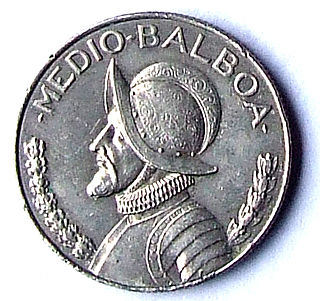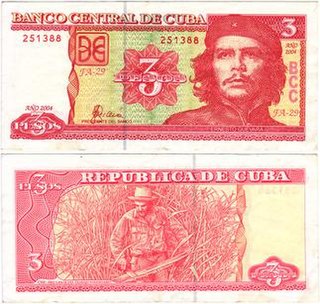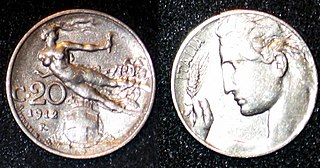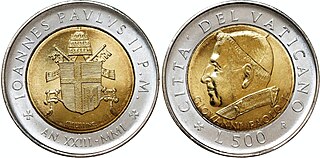
The Mexican peso is the currency of Mexico. Modern peso and dollar currencies have a common origin in the 16th–19th century Spanish dollar, most continuing to use its sign, "$".

The peseta was the currency of Spain between 1868 and 2002. Along with the French franc, it was also a de facto currency used in Andorra.

The Philippine peso, also referred to by its Filipino name piso, is the official currency of the Philippines. It is subdivided into 100 sentimo, also called centavos.

The cent is a monetary unit of many national currencies that equals 1⁄100 of the basic monetary unit.

The Spanish dollar, also known as the piece of eight, is a silver coin of approximately 38 mm (1.5 in) diameter worth eight Spanish reales. It was minted in the Spanish Empire following a monetary reform in 1497 with content 25.563 g (0.8219 ozt) fine silver. It was widely used as the first international currency because of its uniformity in standard and milling characteristics. Some countries countermarked the Spanish dollar so it could be used as their local currency.

The balboa is, along with the United States dollar, one of the official currencies of Panama. It is named in honor of the Spanish explorer/conquistador Vasco Núñez de Balboa. The balboa is subdivided into 100 centésimos.
The centavo is a fractional monetary unit that represents one hundredth of a basic monetary unit in many countries around the world. The term comes from Latin centum, with the added suffix -avo ('portion').

The Cuban peso also known as moneda nacional, is the official currency of Cuba.
Peso dominicano has been the name of the currency of the Dominican Republic since 2010. Its symbol is "$", with "RD$" used when distinction from other pesos is required; its ISO 4217 code is "DOP". Each peso is divided into 100 centavos ("cents"), for which the ¢ symbol is used. With exception of the United States dollar, it is the only currency that is legal tender in the Dominican Republic for all monetary transactions, whether public or private.
Uruguayan peso has been a name of the Uruguayan currency since Uruguay's settlement by Europeans. The present currency, the peso uruguayo was adopted in 1993 and is subdivided into 100 centésimos, although centésimos are not currently in use.

Centesimo is a currency unit equivalent to cent, derived from the Latin centesimus meaning "hundredth". In Italy it was the 1⁄100 division of the Italian lira.
The peso was the currency of Paraguay between 1856 and 1944. It replaced the real at a rate of 8 reales = 1 peso. Until 1870, the peso was subdivided into 8 reales. Paraguay then decimalized, with 100 centésimos = 1 peso. The name of the subdivision was changed to centavo in 1874. The peso was replaced in 1944 by the guaraní at a rate of one hundred to one.

The lira was the currency of the Vatican City between 1929 and 2002. It was not a separate currency but an issue of the Italian lira; the Banca d'Italia produced coins specifically for Vatican City.

The venezolano was the currency of Venezuela between 1872 and 1879. It was divided into 100 centavos, although the names céntimo and centésimo were also used. Venezolano was also the name of two currencies planned in 1854 and 1865.

The lira was the currency of the Kingdom of Sardinia between August 6, 1816, and March 17, 1861.

This is an outline of Uruguay's monetary history. For the present currency of Uruguay, see Uruguayan peso.

The currency of Venezuela has been in circulation since the end of the 18th century. The present currency unit in Venezuela is the Venezuelan bolívar.
This article provides a historical summary of the currency used in Ecuador. The present currency of Ecuador is the United States dollar.
The history of Philippine money covers currency in use before the Hispanic era with gold Piloncitos and other commodities in circulation, as well as the adoption of the peso during the Hispanic era and afterwards.
The Classical Monetary System of the Oriental Republic of Uruguay includes the coins minted by the Oriental Republic of Uruguay between the years 1840 and 1855 in the national territory. These coins were minted entirely within the city of Montevideo, first at the "Taller y Armería Jouve" owned by a French artisan named Agustín Jouve and later at the Casa de Moneda de Montevideo or Casa de Moneda Nacional, which was created for this purpose.












